The content for this article was originally featured on the Communities of Opportunity blog on May 10, 2024.
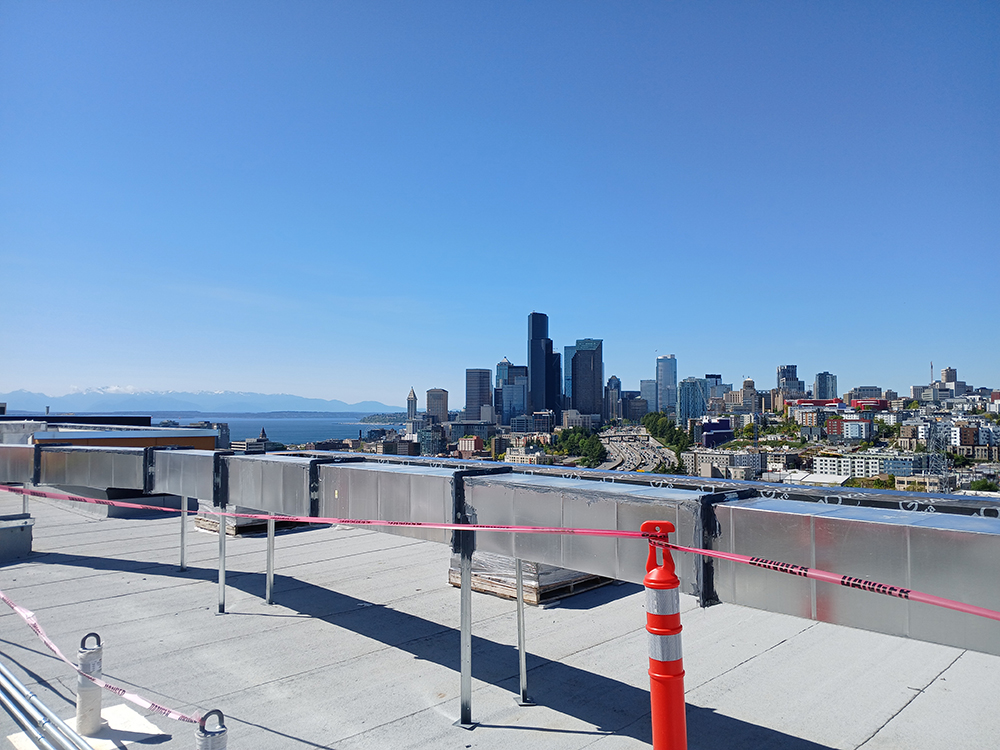
Rooftop views from Beacon Pacific Village are just one of the many appealing features of this new multi-use development. (Photo courtesy of Communities of Opportunity)
The Pacific Tower on Beacon Hill is a landmark on Seattle’s cityscape. Right next door on its ample campus, another landmark is rising – the new Beacon Pacific Village. It will offer affordable housing, childcare, an adult day health center, and more.
On a sunny May afternoon this week, about two dozen people from the affordable housing community got a sneak peek at the innovative mixed-use building in its final months of construction. They were on a tour for Affordable Housing Week, hosted by Weber Thompson, Marpac Construction, and Housing Development Consortium (HDC). The tour will be offered again Friday afternoon, May 17.
Seattle Chinatown International District Preservation and Development Authority (SCIDpda) has been developing Beacon Pacific Village on the site of a former parking lot on the Pacific Tower campus. For years, the project was known as “North Lot.” SCIDpda says by developing this project, they are seeking to preserve communities that are being pushed out of Seattle due to rapidly increase market rents and lack of market-produced family-sized housing.
HDC called the development noteworthy for its “cutting-edge design and sustainable architecture that support affordable, family-sized housing and vital community services.”
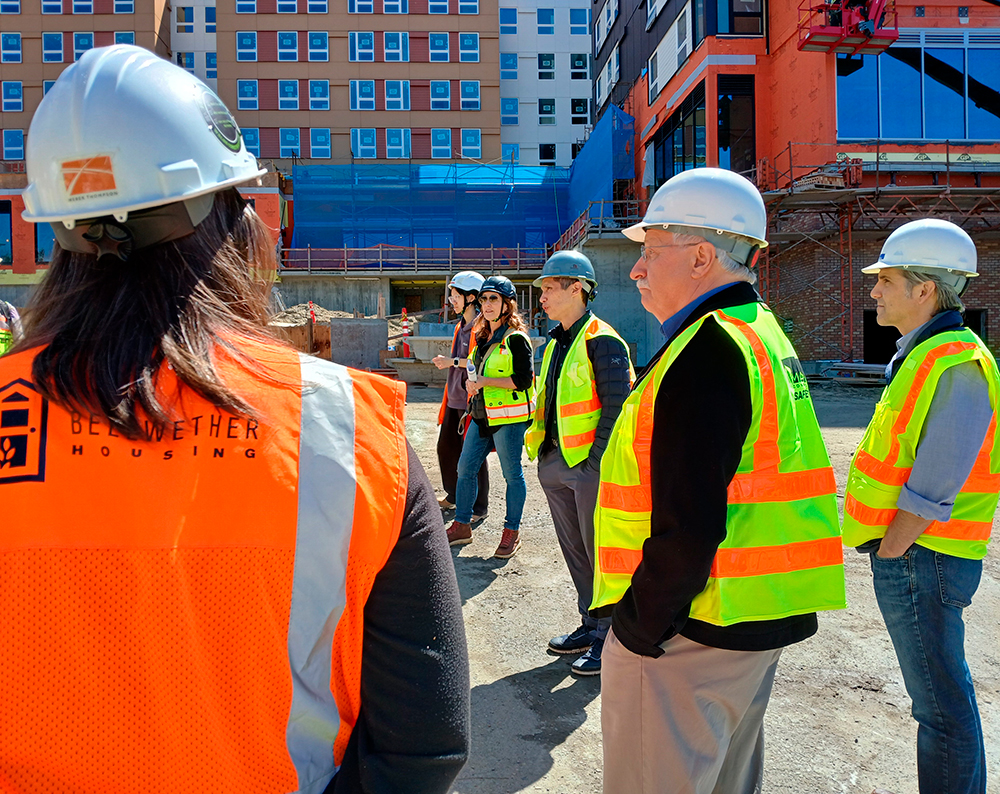
Tour leaders Stephanie Farrell (center) and Joel Ing (to her right). To Stephanie’s left is project engineer Claire Chen. Rep. Frank Chopp is in the foreground with Tony Yuchasz to his right. (Photo courtesy of Communities of Opportunity)
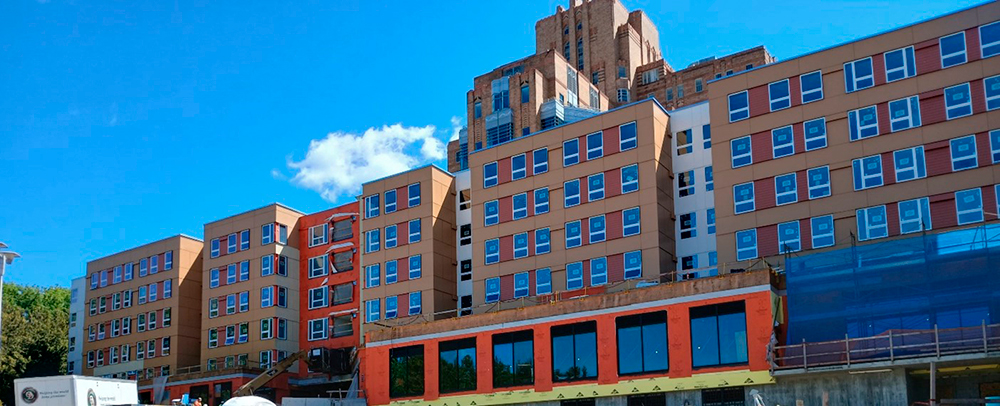
Beacon Pacific Village (front) is on the campus of the historic Pacific Tower (rear). (Photo courtesy of Communities of Opportunity)
A vision for affordable housing
Stephanie Farrell of Weber Thompson, Joel Ing of Edge Development, and Claire Chen of Marpac led the tour. Stephanie and Joel said the building is the vision of Washington State Rep. Frank Chopp (43rd District) and Tony Yuchasz.
-
Rep. Chopp is known as a housing champion and is the former longtime Speaker of the House.
-
Tony works with Rep. Chopp (as an independent contractor) on the Home & Hope initiative, housed at Enterprise Community Partners, to accelerate the development of affordable housing on public and nonprofit land.
For more about the project’s evolution, read Stephanie’s excellent background about the history of North Lot on the Weber Thompson blog.
Stephanie and Joel both credited Rep. Chopp for the fact that the homes are 100% affordable housing. Stephanie explained that originally, the project was planned as a mixed-income development, and Rep. Chopp lobbied successfully to make it 100% affordable.
Joel noted that “a lot of public funders look at the unit count, but we look at the bedroom count.” He explained that the building will offer far more bedrooms than a typical affordable housing development does, because they are often limited to studio apartments and 1-bedrooms. This building is going to help meet the significant need for apartments for large families and multigenerational households.
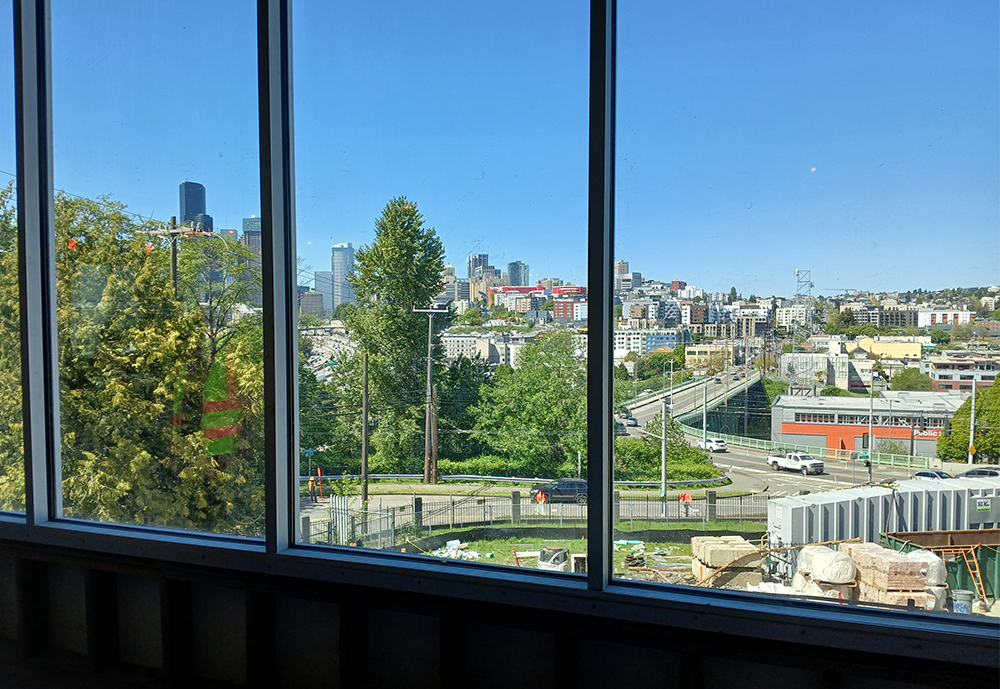
When older adults come to the PACE adult day health program, they will have lots of daylight and a view that overlooks José Rizal Bridge, downtown Seattle, and the International District. (Photo courtesy of Communities of Opportunity)
Meeting the needs of multigenerational community
Beacon Pacific Village will also feature:
- A 24,000 square foot facility for a Program for All-inclusive Care for the Elderly (PACE) program managed by International Community Health Services (ICHS).
- A 10,000 square foot José Marti Child Development Center operated by El Centro de la Raza.
- Two playgrounds.
When SCIDpda signed the agreement with ICHS, Co-Executive Director Jamie Lee said, “What happens on the ground floor of these projects is just as important as the affordable housing we build above.” She said ICHS’ services will “enhance the experiences of residents at the Beacon Pacific Village and provide much-needed care to the communities we serve in the area.”
SCIDpda says that “co-locating childcare facilities and elderly care facilities will provide additional support and services that will allow these families to remain in the communities they have called home for generations.”
During the tour Stephanie, Joel, and Claire fielded questions about multiple aspects of the development, from the early days to the groundbreaking in late 2022 to the planned completion late this summer.
- Architects asked about design considerations, such as how the team was able to affordably complement the historic facade of the Pacific Tower, which has landmark status. They also asked about the challenges of earning HDC’s Exemplary Building Program status.
- Developers asked about the unique financing package, which blends 13 different types of public funding, $120 million total. Funders include the City of Seattle Office of Housing, King County, and Washington State Department of Commerce.
- Others were curious about the number and size of the units, and how affordable they will be using the Area Median Income (AMI) measure.
There are 160 units, from studios to 4 bedrooms. Around 20 percent are family-sized with 3 or 4 bedrooms and in-unit laundry facilities.
70% of the units will be affordable to people making 50% of the AMI, and 30% will be affordable to people making 60% of the AMI. Housing is considered affordable if the occupant is paying no more than 30 percent of gross income for housing costs, including utilities.
The building will also spotlight numerous works of art. A mural by Pacific Northwest artist Jean Bradbury will greet people at this main entrance to Beacon Pacific Village (above). Two other murals on the exterior are being created by Dave Young Kim (for the mural on an out-facing bioretention wall to the north) and Community Rejuvenation Project (on the large concrete wall that faces the interior courtyard).
More art will adorn the interior walls of Beacon Pacific Village.
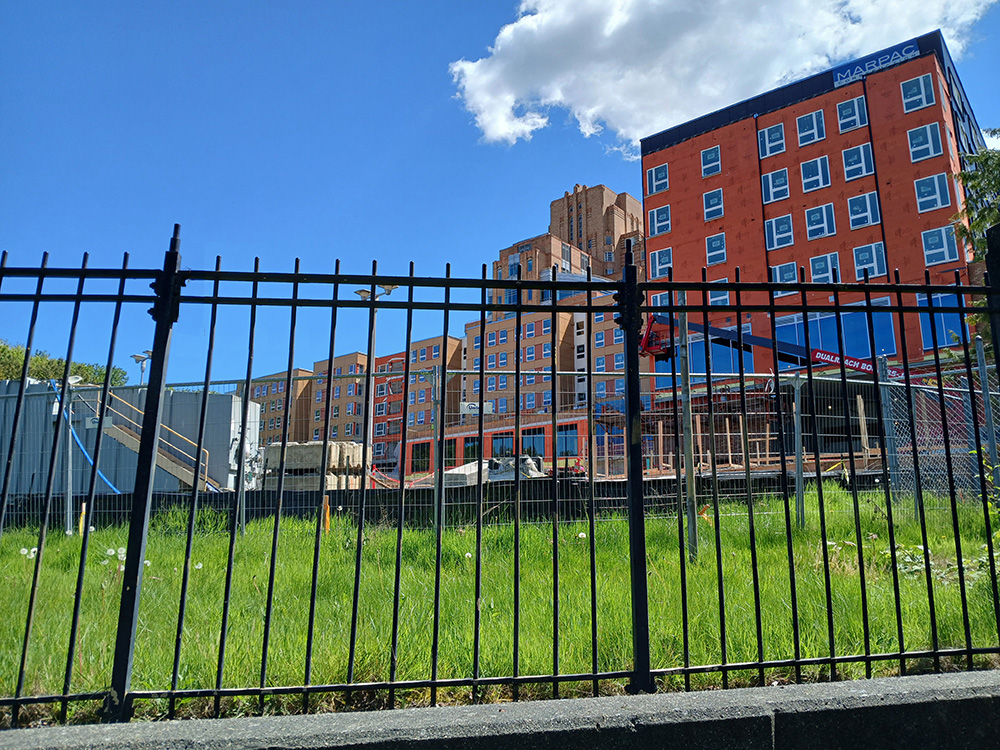
The view from 12th Avenue South looking west. In Phase 2, more than 100 more homes will be built on this area of the campus. (Photo courtesy of Communities of Opportunity)
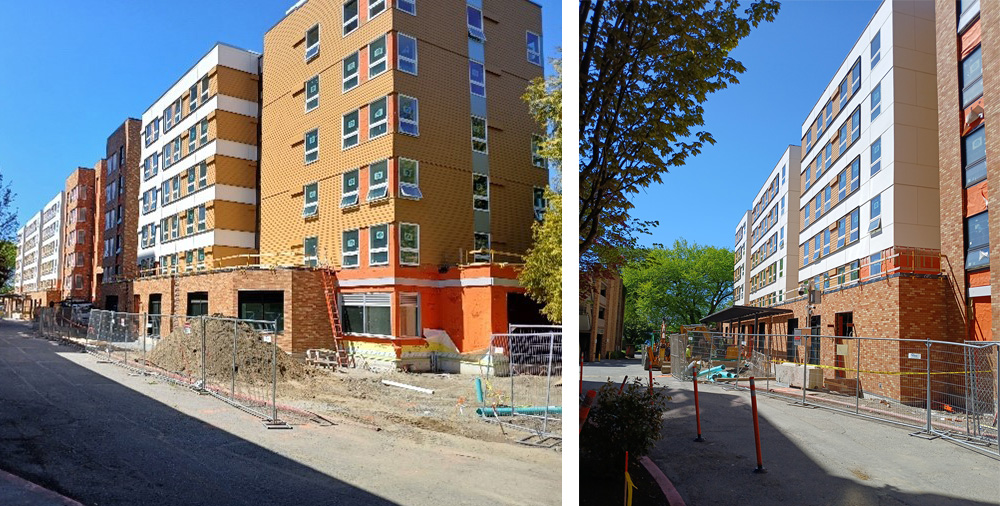
Left: The childcare center, in the ground floor building on the right, will have a drop-off area. Left: The PACE adult day health center will have a bus waiting area for shuttle buses, under the covered area. (Photo courtesy of Communities of Opportunity)
The tower on the hill – a famous neighbor
The Pacific Tower is a famous art deco building that formerly housed a U.S. public health service hospital and the headquarters of Amazon, among others. High on Beacon Hill, it’s visible from many areas in central and south Seattle, especially when it’s lit up at night.
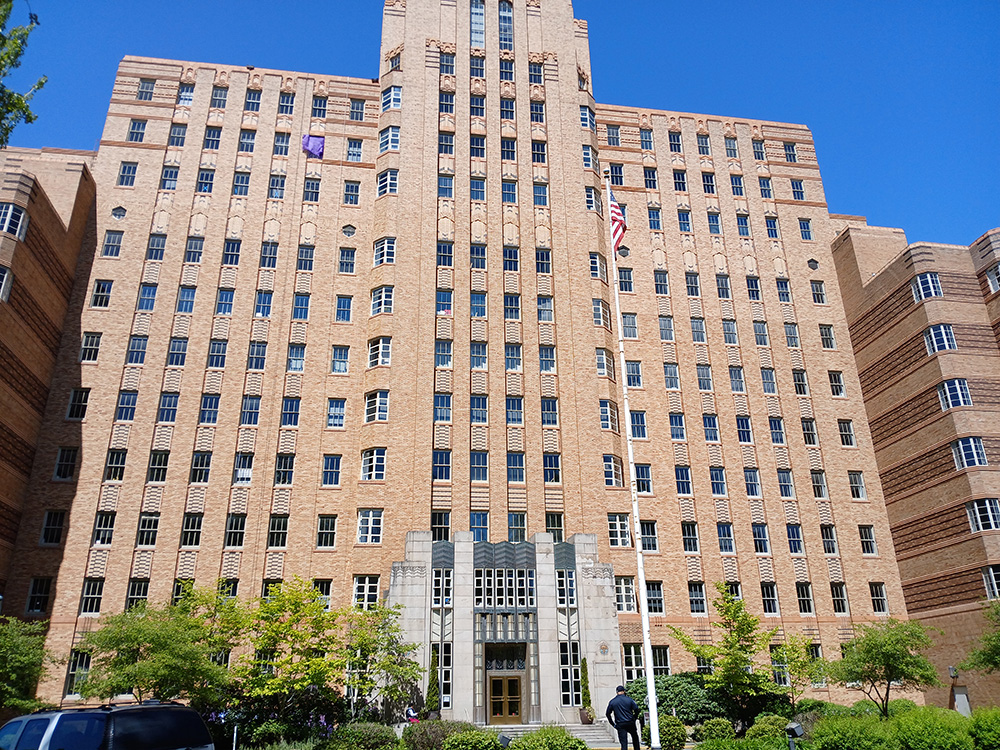
The main entrance of the art deco landmark, the Pacific Tower. (Photo courtesy of Communities of Opportunity)
Today, it’s become a home for health and housing organizations. It’s the site of a Pac Med clinic and the home of Seattle Central College’s Health Education Center. Rep. Chopp said 1,400 students per year get degrees there. You can also find the offices of numerous nonprofit organizations working on health, housing, education, and related issues. Chopp himself has an office there.
Intentional design for health, comfort, and history
Many points on this campus offer scenic views of the city, and the location is in a neighborhood with important cultural relevance. It’s situated right at the edge of the International District and Beacon Hill. Both of these communities were disrupted and displaced by the construction of the I-5 and I-90 freeways.
Because of the site’s proximity to the freeways, and its location under flight paths from SeaTac, the developers worked to mitigate air quality and other environmental issues. They’re using a modern Energy Recovery Ventilation (ERV) system and an upgraded building envelope (which includes the roof, walls, doors, and floors), providing clean air and reducing outside noise pollution for tenants. Triple-pane insulated windows block exterior noise and offer greater air quality. Insulated walls will block interior noise and further contribute to a quieter atmosphere.
Along the way, the team found creative solutions to the construction issues that typically arise, such as a shortage in materials. One example is the gypsum concrete, or “gyp-crete,” that builders use under flooring. When the team ran into a gyp-crete shortage, instead of working with one gyp-crete sub-contractor – the usual approach — they negotiated with two so they’d have enough materials to finish. They then alternated using the differently sourced gyp-crete on different floors.
As they designed Beacon Pacific Village, the architects from Weber Thompson also took on the challenge of honoring the distinctive brick and exterior facing of the Pacific Tower. One major solution was the brick they used, which is locally produced. Because of cost savings, they’ll be able to use more brick than they originally planned, adding to the building’s aesthetic appeal and connection to Pacific Tower.
Another touch that ties the two buildings together is a set of four iconic street lamps being donated by Pacific Tower’s owner, Pacific Hospital Public Development Association (PHPDA). The lamps will be used for wayfinding and for the entrance.
Stephanie had kicked off the tour by saying it was an honor to work on this project. Afterwards, she said Beacon Pacific Village “embodies Community, Collaboration and Partnership.
“Everyone involved is vested in the mission of providing housing that allows families of all incomes to remain part of the rich Seattle community. It’s this shared passion and commitment that has enabled us to stay on budget, while making choices that will provide a beautiful and sustainably-built place for folks to call home,” she said.